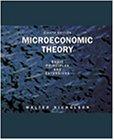20.10 In Example 20.5 we showed that the Nash equilibrium in this first-price, sealed bid auction was
Question:
20.10 In Example 20.5 we showed that the Nash equilibrium in this first-price, sealed bid auction was for each participant to adopt a bidding strategy of b{v) = [ ( n — l)/n] v. The total revenue a seller might expect to receive from such an auction will obviously be [ { n — l)/n] v*—
where v* is the expected value of the highest valuation among the n auction participants.
a. Show that if valuations are uniformly distributed over the interval [0, 1 ], the expected value for v* is n/(n + 1 ) . Hence expected revenue from the auction is (n — l ) / ( n + 1).
Hint: The expected value of the highest bid is given by E(v*) = f vf{v)dv
Fantastic news! We've Found the answer you've been seeking!
Step by Step Answer:
Related Book For 

Microeconomic Theory Basic Principles And Extensions
ISBN: 9780030335938
8th Edition
Authors: Walter Nicholson
Question Posted:






